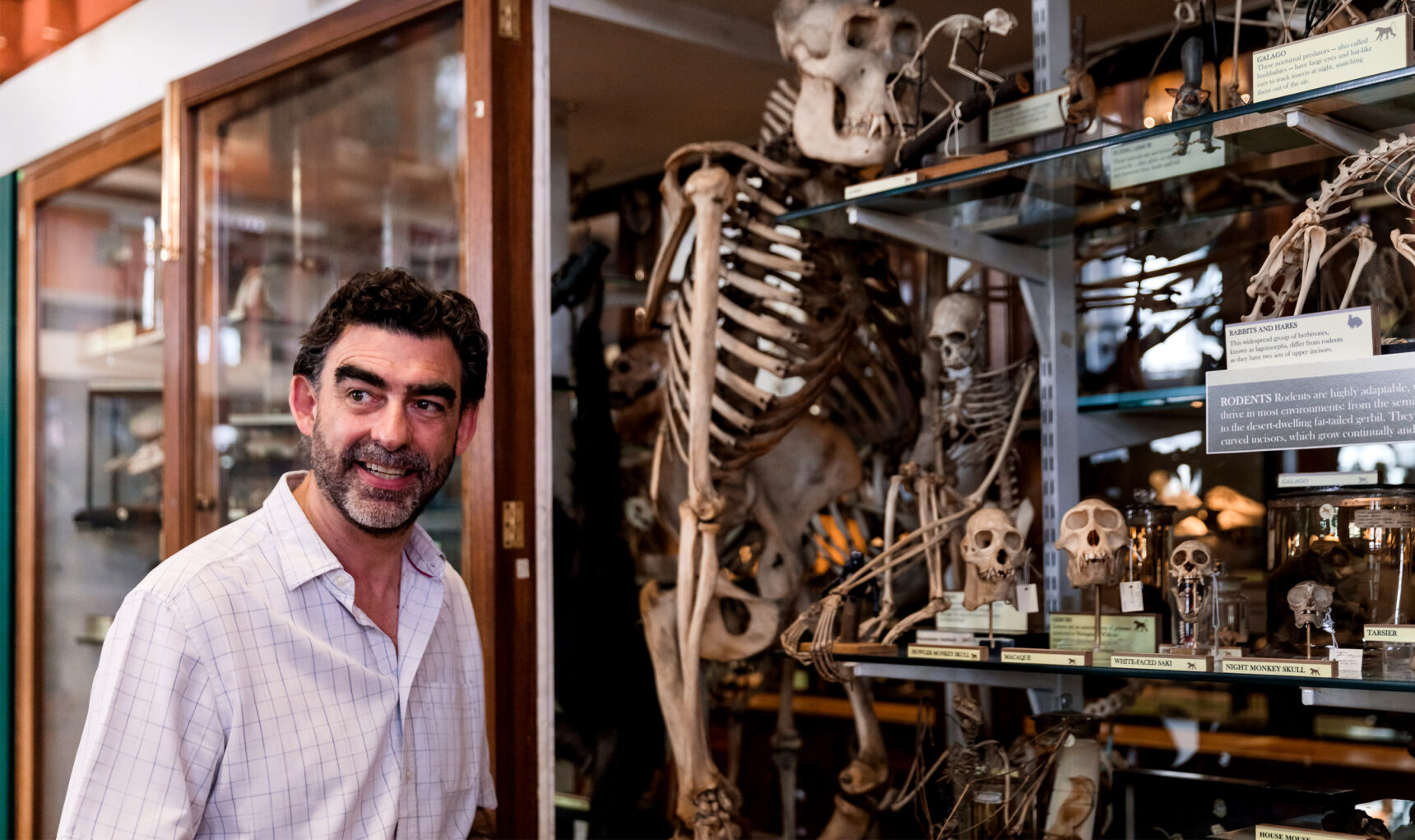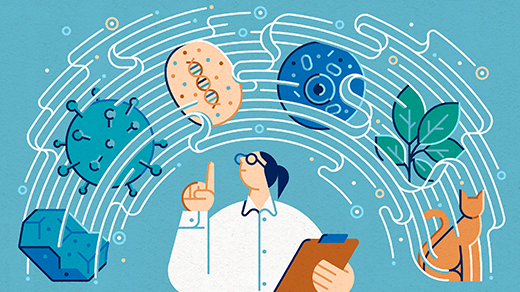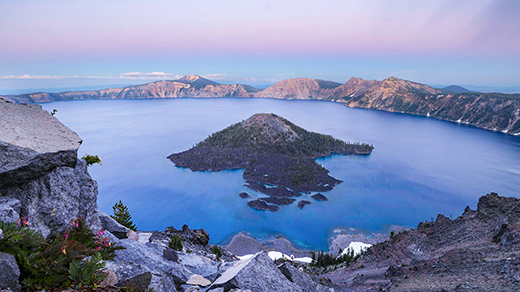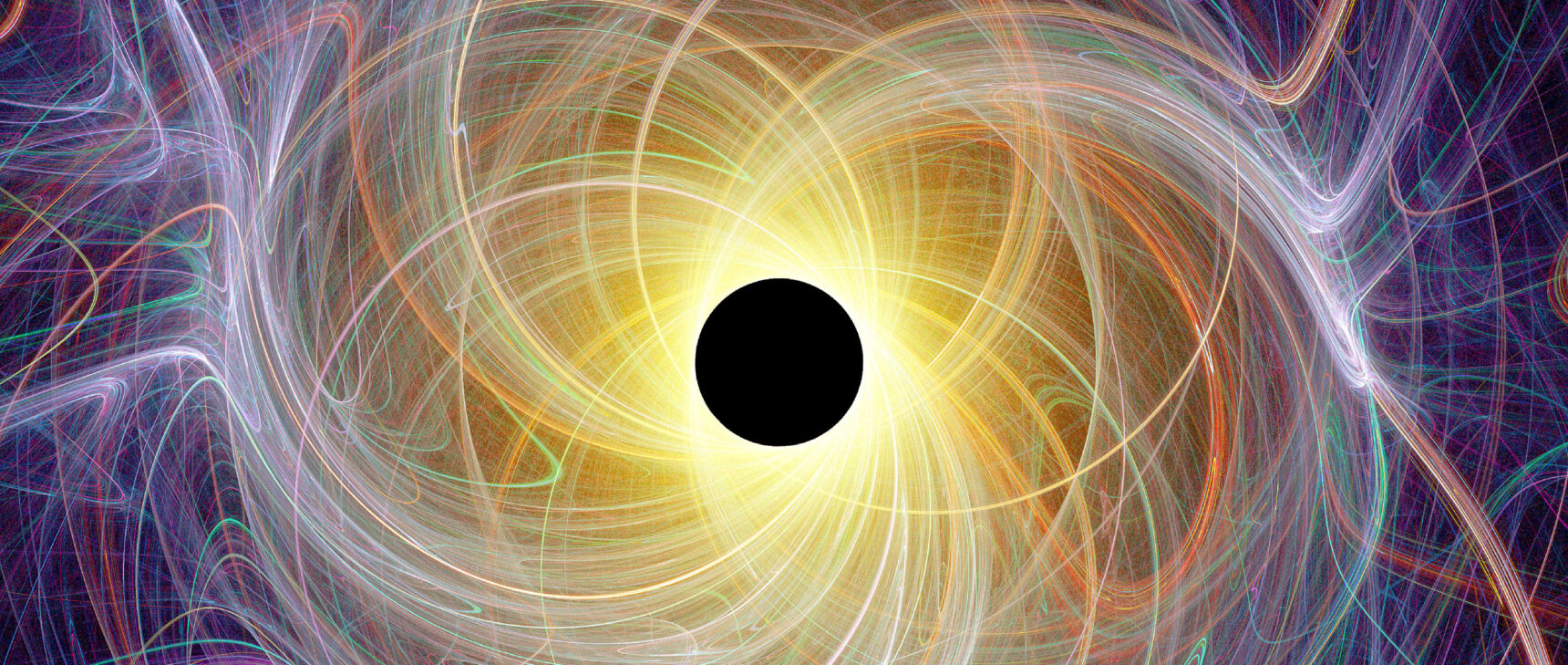A Biochemist’s View of Life’s Origin Reframes Cancer and Aging
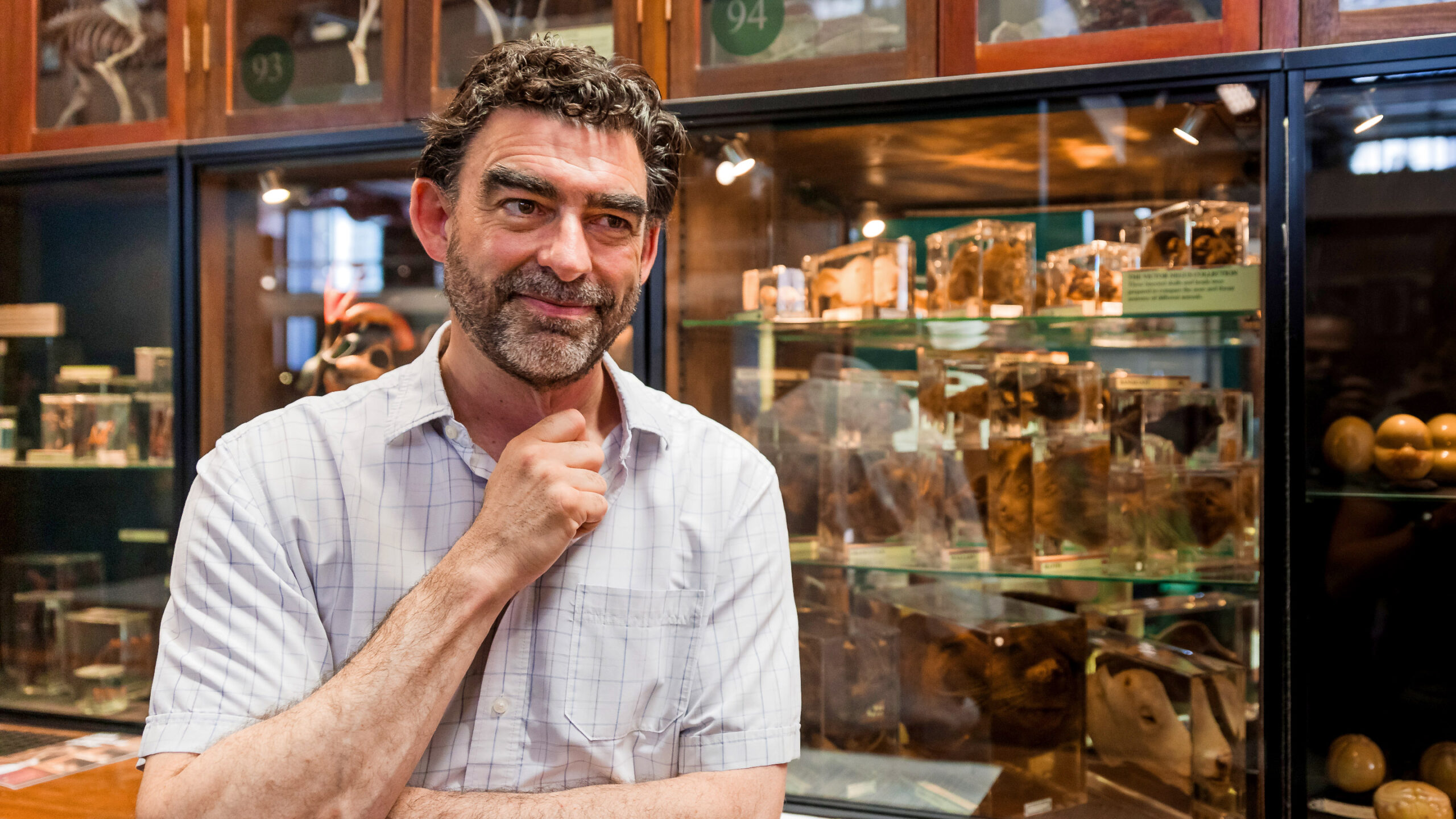
In contrast to many other researchers who study the origin of life, Nick Lane, a professor of evolutionary biochemistry at University College London, suggests that some form of primitive metabolism may have arisen in deep-sea hydrothermal vents before the appearance of genetic information.
Philipp Ammon for Quanta Magazine
Introduction
All living cells power themselves by coaxing energetic electrons from one side of a membrane to the other. Membrane-based mechanisms for accomplishing this are, in a sense, as universal a feature of life as the genetic code. But unlike the genetic code, these mechanisms are not the same everywhere: The two simplest categories of cells, bacteria and archaea, have membranes and protein complexes for producing energy that are chemically and structurally dissimilar. Those differences make it hard to guess how the very first cells met their energy needs.
This mystery led Nick Lane, a professor of evolutionary biochemistry at University College London, to an unorthodox hypothesis about the origin of life. What if life arose in a geological environment where electrochemical gradients across tiny barriers occurred naturally, supporting a primitive form of metabolism while cells as we know them evolved? A place where this might be possible suggested itself: alkaline hydrothermal vents on the deep seafloor, inside highly porous rock formations that are almost like mineralized sponges.
Lane has explored this provocative idea in a variety of journal papers, and he has touched on it in some of his books, such as The Vital Question, where he wrote, “Carbon and energy metabolism are driven by proton gradients, exactly what the vents provided for free.” He describes the idea in more detail for the general public in his latest book, Transformer: The Deep Chemistry of Life and Death. In his view, metabolism is central to life, and genetic information emerges naturally from it rather than the other way around. Lane believes that the implications of this reversal touch almost every big mystery in biology, including the nature of cancer and aging.
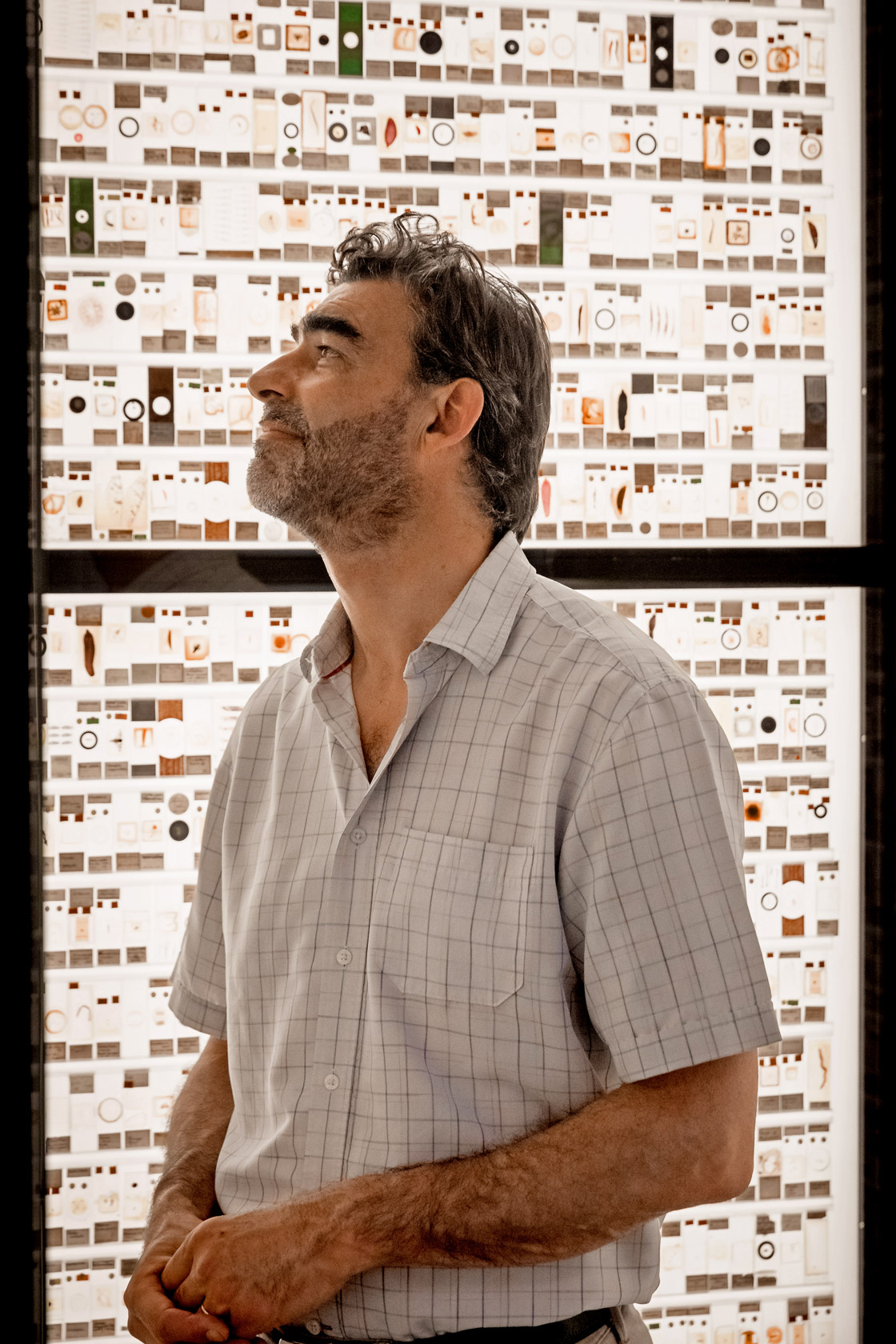
Inside the porous inorganic material around deep hydrothermal vents, organic molecules could have been organized into cell-like entities that made more of themselves. “It’s a very rough form of growth, but it’s lifelike in that sense,” Lane said.
Philipp Ammon for Quanta Magazine
Lane’s theory is still only one among many in the scrappy field of origin of life studies. Many if not most scientists stand by theories that life started with self-replicating mixtures of RNA and other molecules, and that it arose on or near Earth’s surface, nurtured by sunlight. Studies of hydrothermal vents as crucibles for life have boomed in recent decades, but some of them favor volcanic vents in freshwater, not deep vents on the seafloor. Still, while Lane’s explanation doesn’t answer all the questions about how life started, it addresses difficult ones about how the energy-intensive synthesis of proteins and other essential biomolecules could have occurred.
Research into how the need for energy has influenced and constrained the evolution of life has always been a central theme of Lane’s career as both a scientist — with more than 100 papers in peer-reviewed journals to his credit — and a science writer. Lane received the 2015 Biochemical Society Award for his contributions to the life sciences, and in 2016 the Royal Society of London presented him with its Michael Faraday Prize for excellence in communicating science to the public.
Quanta recently spoke with Lane at his home in London via videoconference. The interview has been condensed and edited for clarity.
Your book argues that the flow of energy and matter structures the evolution of life and is how metabolism “conjures genes into existence.” What’s the most compelling reason to think metabolism, not genetic information, evolved first?
The purist view of “information first” is the RNA world, where some process in the environment makes nucleotides, and the nucleotides go through a process that makes them link up into polymer chains. Then we have a population of RNAs, and they invent everything, because they’re capable of both catalyzing reactions and copying themselves. But then how did the RNAs invent all of metabolism, cells, spatial structure and so on? Genes don’t actually do that even today. Cells come from cells, and genes go along for the ride. So why would genes do it at the very beginning?
And how would they do it? Let’s say there are 10 steps in a biochemical pathway, and any one step by itself is not of much use. Every product in a pathway would have to be useful for it to evolve, which is not the case. It just looks so difficult to evolve even a single pathway.
What’s the alternative?
The alternative is that these things happen spontaneously under favorable conditions, and that you get very small amounts of interconversion from one intermediate into the next intermediate all the way down that whole pathway. It wouldn’t be very much, and it wouldn’t be very fast compared to enzyme-catalyzed reactions, but it would be there. Then when a gene arises at some later stage, it can catalyze any of those steps, which will tend to speed up the whole pathway.
That makes the problem much easier. But it also makes this unnerving prediction that all of the chemistry in this pathway has to be favored. And then you say that for another pathway and another, and it becomes an increasingly scary proposition that the core of biochemistry just happens to be thermodynamically favored in the absence of genes.
Six or seven years ago, this was not a position easy to sustain, because there was no evidence for it, really. But since then, at least three or four of these pathways have been demonstrated to happen spontaneously and at low levels in the lab. Not all the pathways are complete, but intermediate steps occur. It begins to look as if it’s not an unreasonable position to say genes came into existence in a world where we already had some quite sophisticated proto-metabolism.
Let’s talk about how the proto-metabolism could have evolved in deep-sea hydrothermal vents. What is it about the vent environment that makes you think it favored the beginnings of what we call the Krebs cycle, the metabolic process that derives energy from carbohydrates, fats and proteins?
Let’s start with what life is starting with: hydrogen and carbon dioxide, which don’t react very easily. How does life make them react? As we see in mitochondria and in certain bacteria, life uses an electrical charge on the membrane to transfer electrons from hydrogen onto iron sulfur proteins like ferredoxin. These tiny clusters of iron ions and sulfur ions at the heart of ancient proteins are like little minerals. You get these minerals in hydrothermal vents, and you also get carbon dioxide and hydrogen, and there are even thin barriers in the porous rock with an electrical charge on them.
The question is: Does this structure at the vents effectively drive the reaction between carbon dioxide and hydrogen? And the answer we’re finding in the last year or two in the lab is yes, it really does. We don’t get a lot, but we’re getting more as we begin to optimize our process, and what we’re seeing produced is Krebs cycle intermediates. And if you put some nitrogen in, you get the same amino acids that life is using.
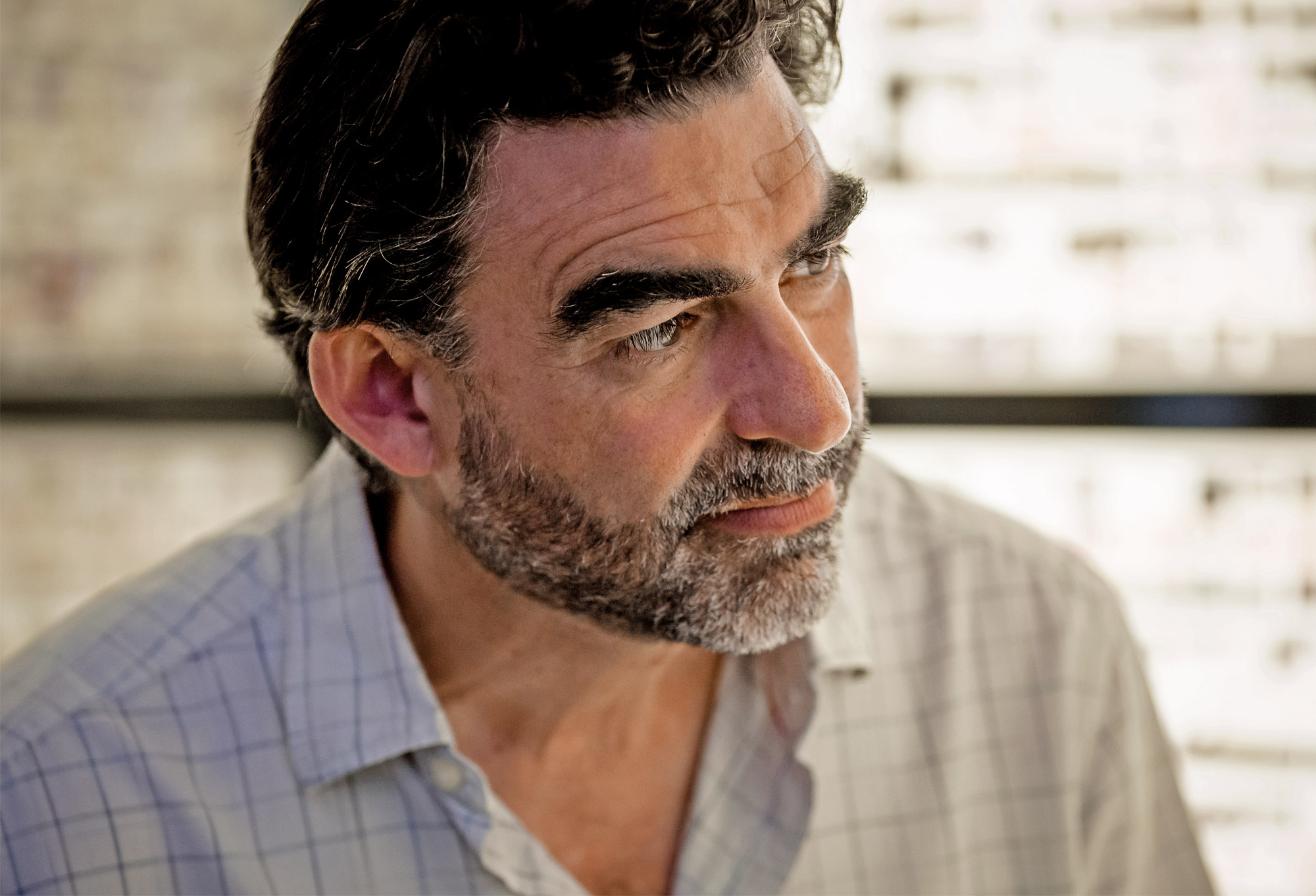
“Cancers aren’t caused simply by some genetically deterministic mutation that forces cells to go on growing without stopping,” Lane said. “Metabolism is important too, for providing a permissive environment for growth.”
Philipp Ammon for Quanta Magazine
So this chemistry is thermodynamically favored. It’s just these first steps which are recalcitrant, but the electrical charges on the hydrothermal vent seem to lower the barrier to that first step, so the rest can happen. In effect what you have is a continuous flow of hydrothermal fluids going through this electrochemical reaction, converting gases in the environment into more organic molecules, which you can imagine snuggling into the cell-like pores, structuring themselves into cell-like entities and making more of themselves. It’s a very rough form of growth, but it’s lifelike in that sense.
But then how did these first proto-cells become independent from the proton gradients they got for free in the hydrothermal vents?
A lot of this remains speculative, but the answer seems to be that you need genes to be independent. And so this is a fundamental question: Where and when are the genes coming in?
We’ve shown that theoretically, if you introduce random sequences of RNA and assume that the nucleotides in there can polymerize, you get little chains of nucleotides. Let’s say seven or eight random letters long, with no information encoded in there whatsoever. There’s two ways this can now really help you. One is that it acts as a template for more RNA: It’s capable of templating an exact copy of the same sequence, even if that sequence has no information in it. But the second thing it can do in principle is act as a template for amino acids. There are patterns of nonspecific biophysical interactions between amino acids and the letters in RNA — hydrophobic amino acids are more likely to interact with hydrophobic bases.
So you have a random sequence of RNA that generates a nonrandom peptide. And that nonrandom peptide could by chance have some function in a growing proto-cell. It could make the cell grow better or grow worse; it could help the RNA replicate itself; it could bind to cofactors. Then you have selection for that peptide and the RNA sequence that gave rise to it. Although it’s a very rudimentary system, this means we’ve just entered the world of genes, information and natural selection.
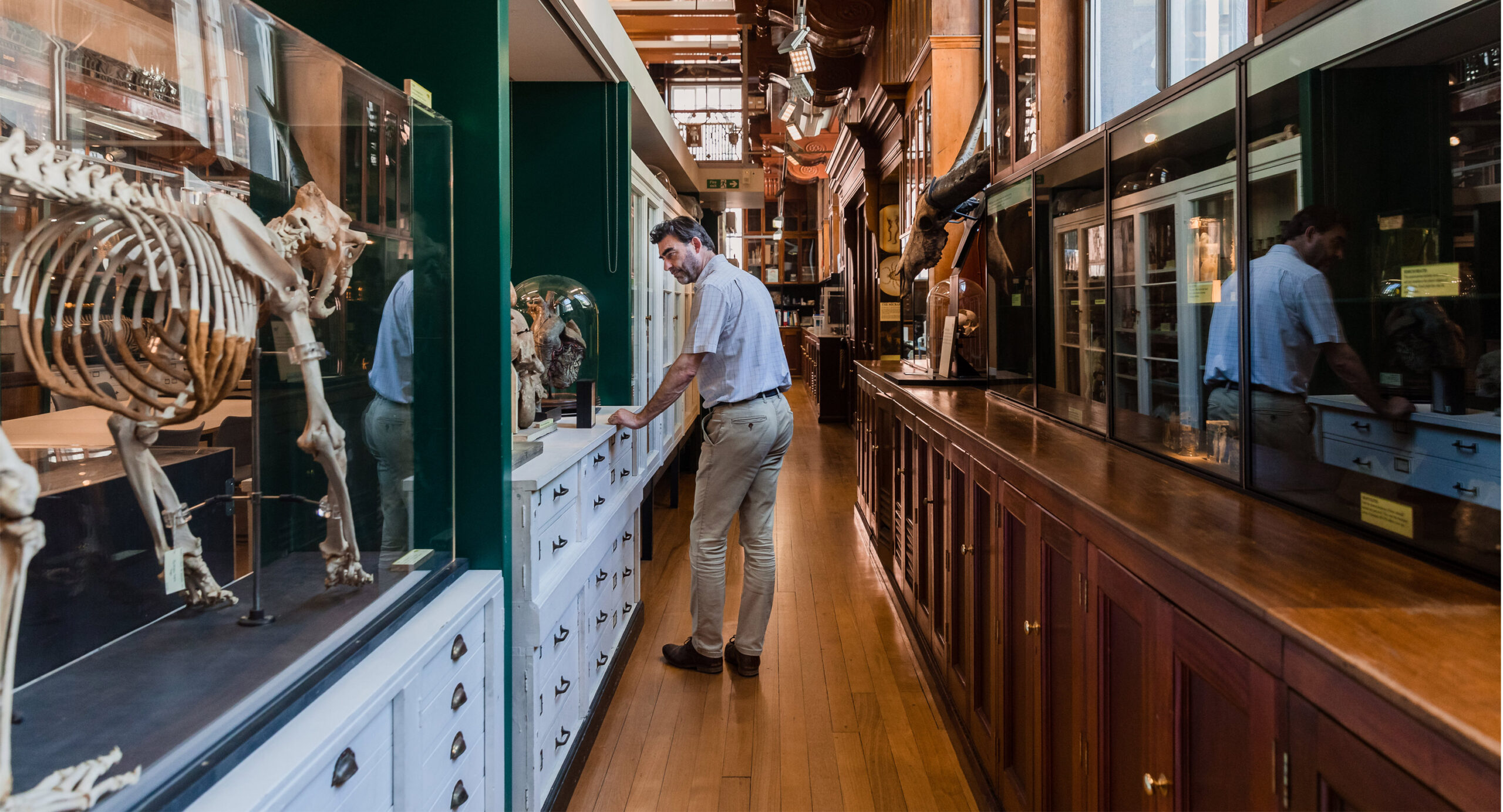
Aging is an inevitable consequence of the torrent of metabolic reactions flowing through our bodies at every instant, Lane believes: “We can’t reverse its flow, but we can perhaps hope to channel it a little better between the banks.”
Philipp Ammon for Quanta Magazine
We’ve just gone from a system without information to a system with information, with hardly any change in the system itself. All we’ve done is introduce random RNA. Now, is it true? They say the most beautiful ideas can be killed with ugly facts. And it may not be true, but it has such high explanatory power that I can’t believe it’s not true.
So in the hydrothermal vents we get some Krebs cycle intermediates. But then how did they all come together as a cycle? Is it significant that this works as a cycle rather than as a linear chain of reactions?
We often focus on the Krebs cycle performing the same energy-generating reactions over and over. But the Krebs cycle can operate in both directions. In our mitochondria, it strips carbon dioxide and hydrogen out of intermediate molecules to generate an electrical charge on a membrane for energy. In many ancient bacteria, however, it does exactly the opposite: It uses the electrical charge on a membrane to drive reactions with carbon dioxide and hydrogen to make those intermediates, which become precursors for making the amino acids needed for growth.
And it’s not just in ancient bacteria — our cells still use the Krebs cycle for biosynthesis too. We’ve known since the 1940s that the Krebs cycle can sometimes run backward in our cells, and that its intermediate molecules are sometimes used as precursors for making amino acids. Our mitochondria are balancing two opposing processes, energy generation and biosynthesis, based on the needs of our cells. There’s a kind of yin and yang about this.
The Krebs cycle never really operated as a true cycle except in the most highly energetic cells, like the flight muscles of pigeons, where it was first discovered. In most cells, the Krebs cycle is more like a roundabout than a cycle, with things coming in and going out at different points. And it’s a roundabout that can go in both directions, so it’s kind of messy.
How was the rise of oxygen connected to the favored direction of metabolic flux and the evolution of the first multicellular animals?
The first animals seem to have been evolving when oxygen levels were really low much of the time. They crawled around in mud that was full of sulfide, like the gases in a sewer. These early worms needed some oxygen to crawl, but they also needed to detoxify all this sulfide and deal with a lot of carbon dioxide in their environment.
It dawned on me that the only way you can do that is by having different types of tissue that do different jobs. As soon as you’re crawling, you need muscles, and you need some kind of a respiratory system. That’s two different types of tissue, one of which must retain oxygen and provide it when you need it, while the other tries to operate in the absence of oxygen. They have to do their biochemistry in different ways, with different fluxes through their Krebs cycle. You’re kind of forced to do two or three things at once.
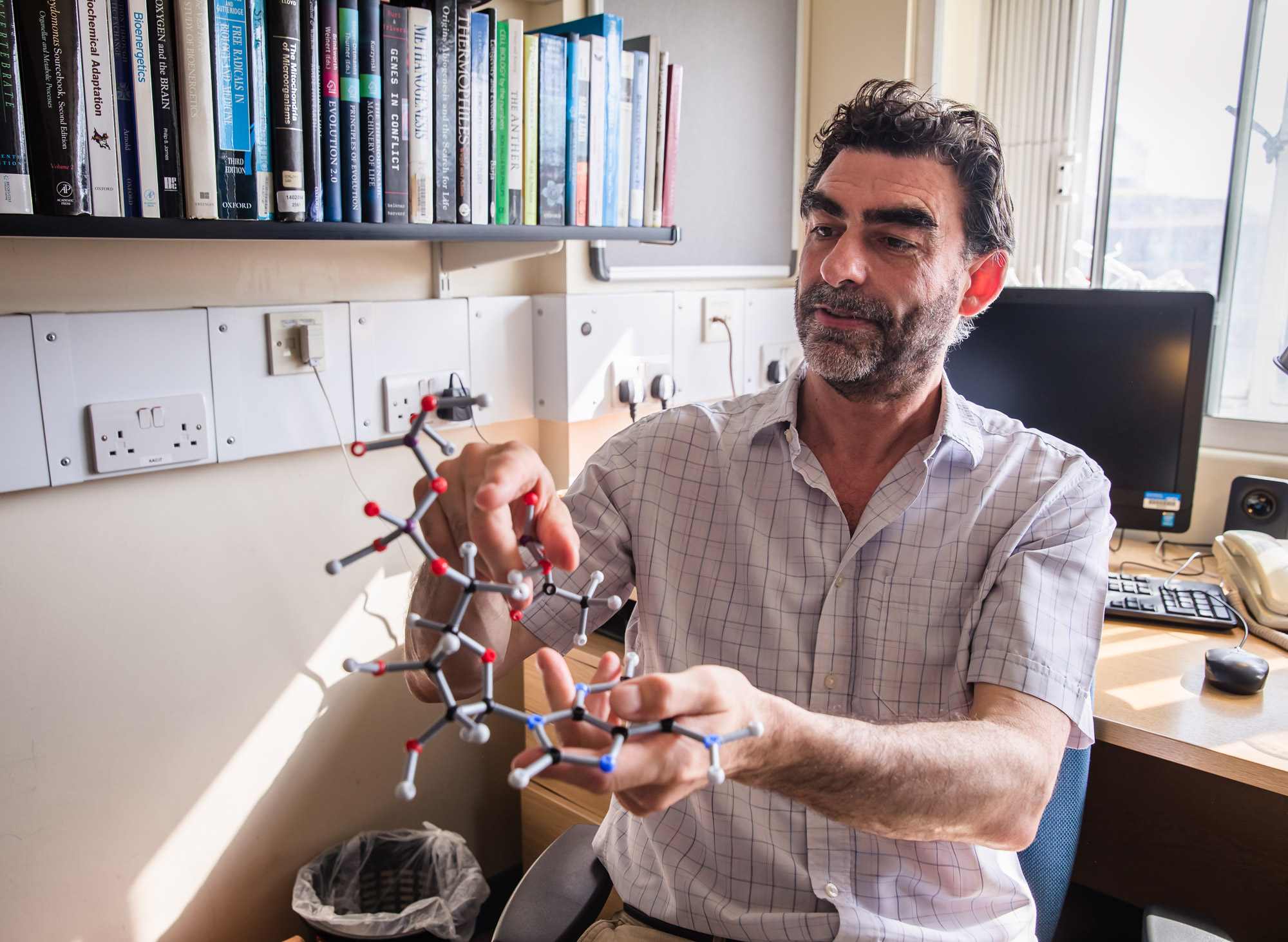
Cells run the biochemical process called the Krebs cycle in both directions as needed to balance their needs for energy generation and biosynthesis. “There’s a kind of yin and yang about this,” Lane said.
Philipp Ammon for Quanta Magazine
Now, in contrast, there was this mysterious group of simple organisms called the Ediacaran fauna. They lived about 200 meters deep in the ocean and fell extinct right before the Cambrian explosion about 540 million years ago, when oxygen levels in the environment fell. The Ediacaran fauna didn’t have much tissue differentiation, and they could only do one thing biochemically at a time. When oxygen levels fell right before the Cambrian, they couldn’t adapt to the new environments.
But as soon as you have multiple tissues, you can do things in parallel. You can balance what this tissue is doing with what that tissue is doing. You can’t do energy and biosynthesis equally at the same time very easily — it’s easier to do one or the other. That kind of forces us to have different metabolisms in different tissues.
So tissue differentiation is not only about having genes that say, “This is going to become a liver,” or “This is going to become nervous tissue.” It allows lifestyles that were just not possible before, and it allowed the first worms to get through bad conditions that killed everything else. The Cambrian explosion happened after that. When oxygen levels finally did rise, these glorified worms with multiple tissues were suddenly the only show in town.
This ties into some of your ideas about cancer. Since the 1970s, most of the biomedical establishment working to cure and prevent cancers has focused on oncogenes. Yet you argue that cancer isn’t a genomic disease so much as a metabolic one. Can you explain why?
About 10 years ago, the cancer community was amazed by the discovery that in some cancers, mutations can lead to parts of the Krebs cycle running backward. It came as quite a shock because the Krebs cycle is usually taught as only spinning forward to generate energy. But it turns out that while a cancer cell does need energy, what it really needs even more is carbon-based building blocks for growth. So the whole field of oncology began to see this reversal of the Krebs cycle as a kind of metabolic rewiring that helps cancer cells grow.
This discovery also caused a reinterpretation of the fact that cancer cells grow primarily by what’s called aerobic glycolysis. In effect, cancer cells switch from burning oxygen in their mitochondria for respiration to fermenting for energy like yeast cells, even in the presence of oxygen. When Otto Warburg reported this nearly 100 years ago, he focused on the energy side. But the cancer community now sees this change is about growth. By switching to aerobic glycolysis for energy, cancer cells free up their mitochondria for other purposes. Cancer cells have biosynthetic mitochondria for making the building blocks of life.
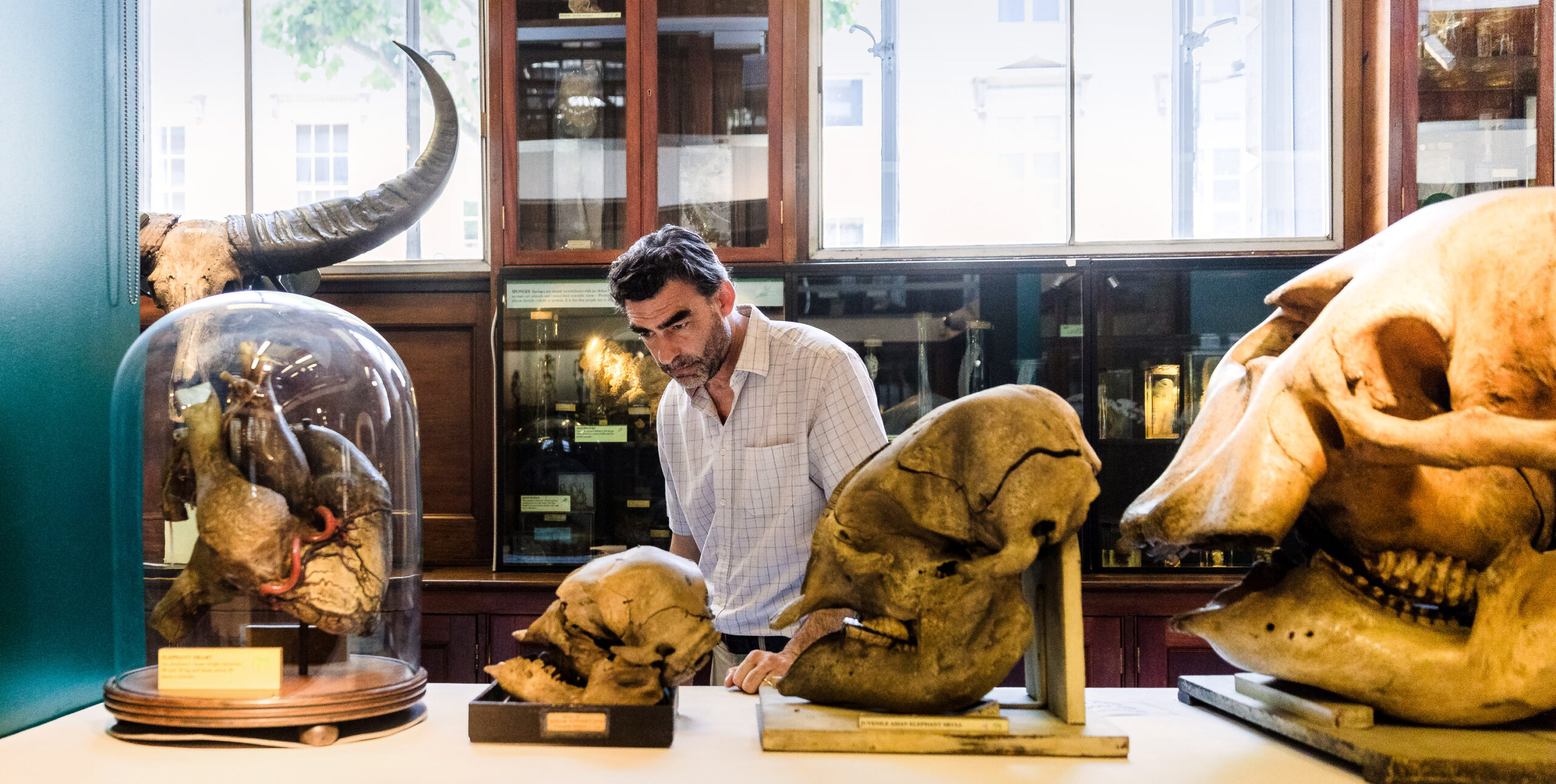
In challenging environments, multicellular animals can segregate useful but incompatible biochemical tasks into different tissues. “You can do things in parallel,” Lane said. “You can balance what this tissue is doing with what that tissue is doing.”
Philipp Ammon for Quanta Magazine
It’s true that you see oncogene mutations in cancers. But cancers aren’t caused simply by some genetically deterministic mutation that forces cells to go on growing without stopping. Metabolism is important too, for providing a permissive environment for growth. Growth comes before genes in this sense.
What makes us more vulnerable to cancer as we get older, if it’s not an accumulation of mutations?
I think any damage to respiration that slows down the Krebs cycle makes it more likely to reverse into biosynthesis. As we get older and accumulate all kinds of cellular damage, this central part of our metabolism is maybe more likely to start going backward, or to not go forward as effectively. That means we will have less energy; it means that we will begin to put on weight because we start turning carbon dioxide that we would exhale back into organic molecules. Our risk of diseases like cancer increases because we have a metabolism that is prone to that kind of growth.
The gerontology community has been talking along these lines for 10 to 20 years. The greatest risk factor for age-related diseases isn’t mutations; it’s being old. If we could solve the underlying process of aging, then we could cure most age-related diseases. It seems tantalizingly simple in many respects. Are we really going to suddenly live to 120 or 800? I don’t see it happening sometime soon. But then the question is, why not?
Why do we age? What causes the mounting cellular damage?
We’ve discovered over the last five or six years that Krebs cycle intermediates are potent signals. So if the cycle slows down and begins to go backward, then we begin to accumulate intermediates, and things like succinate begin to bleed out of the mitochondria. They switch on and off thousands of genes, and they change the epigenetic state of cells. Aging reflects your state of metabolism.
We tend to forget that metabolism involves maybe 20 billion reactions a second, second after second, in every single cell in your body. The sheer volume of molecules being transformed continuously, in all these pathways, including right to the heart of the Krebs cycle, is overwhelming. It’s an inexorable river of reactions. We can’t reverse its flow, but we can perhaps hope to channel it a little better between the banks.
